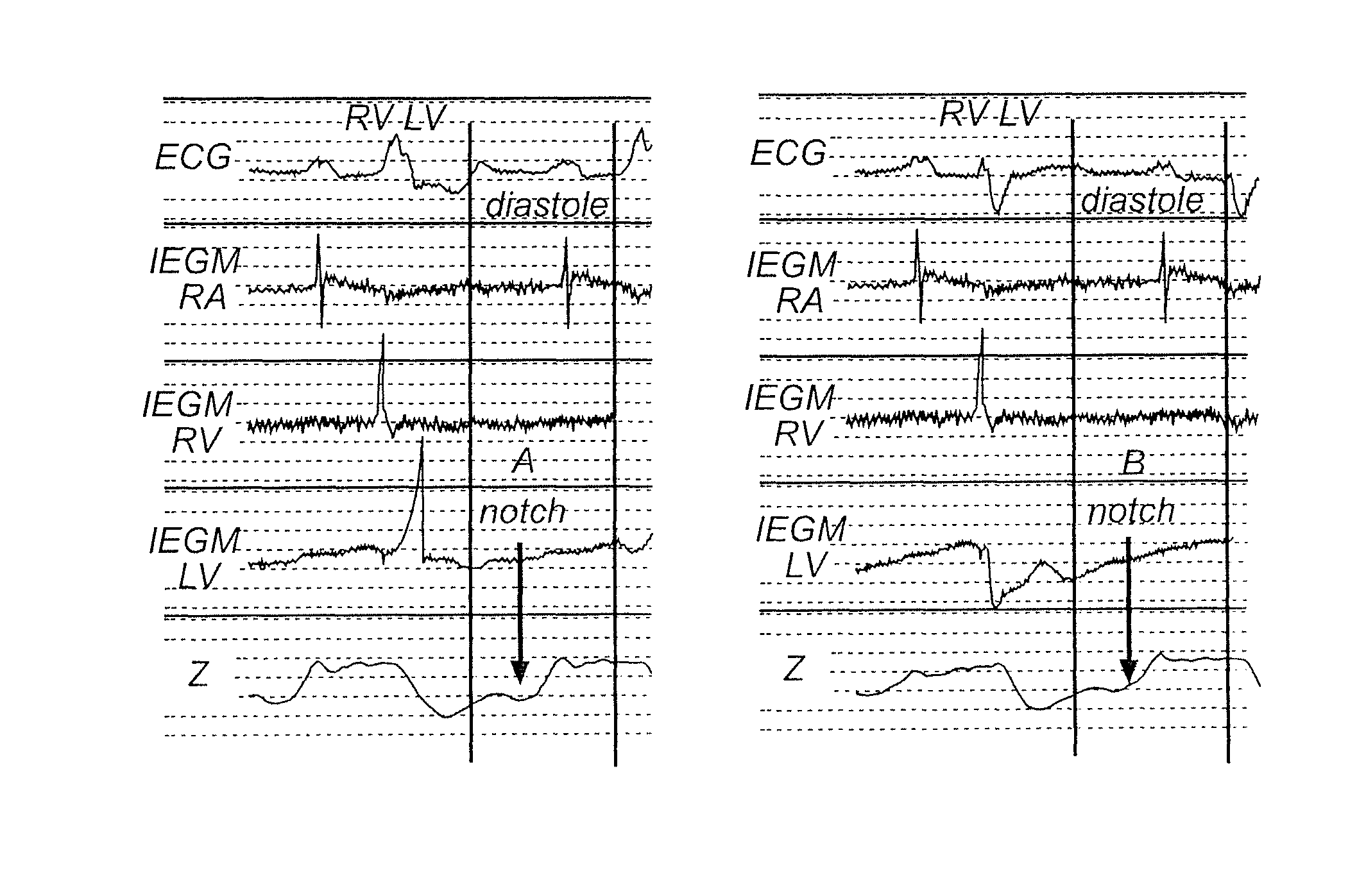[0014]An object of the present invention is to provide an improved device and method for obtaining impedance information that, in accurate and reliable manner, reflects the mechanical functioning of the heart in order to monitor and detect a dyssychronism in the functioning of the ventricles during the change from the rapid filling phase to the slow filling phase.
[0015]The present invention is based on the finding that the intra-cardiac impedance notch is influenced by the synchronicity of the functioning of the ventricles in that the notch becomes a more dominant feature in case of exaggerated dyssynchronicity. The notch is defined as the first positive slope on the negative diastolic impedance slope between end of T-wave and P-wave and there is a close link between the notch and myocardial movements in the change from the rapid filling phase of diastole to the slow filling phase of diastole. The notch is caused by a ventricular wall movement generated by the change from rapid blood inflow to slow blood inflow associated with diastole going from rapid filling to slow filling. In systole, continuous venous return of blood back to the heart is constantly ongoing causing a slight increase in superior vena cava and inferior vena cava pressure. The surplus of venous pressure causes a trajectory of blood in early diastole directly after atrioventricular valves open. As the atrioventricular valve opens and ventricular filling starts, the right and left ventricle are filled rapidly as venous return of blood is ejected into the ventricular cavities. The early filling of blood in the ventricle causes a blood swirl flow in which the blood is flowing or rotating. However, slightly before the swirl blood flow pattern in the early stage of diastole, the blood stream into the ventricle hits the ventricular wall causing it to vibrate, bulge or move. This movement or vibration or level of bulging depends on myocardial wall status or level of disease. In a healthy heart, the right and left heart work synchronously and, hence, the early diastolic movement, bulging, or vibration occurs simultaneously. However, when the right and left ventricle are asynchronous as in the case of heart failure or in bundle branch block, systole and diastole are not synchronous. Rapid filling onset occurs at slightly different time points and therefore, the ventricular wall movement, bulging, or vibration caused by rapid filling will occur at slightly different points of time in the heart cycle. Also, if the left heart wall is in a different state compared to normal, this will influence the movement, bulging or vibration of the left ventricular wall during left side diastole. The present invention is based on this insight and utilizes intra-cardiac impedance to measure these wall vibrations. These wall vibrations are transported through the myocardial wall, and can thus be detected from the right ventricle. In the case of a synchronous heart, the right heart diastolic notch and left heart diastolic notch coincide. In the case of an asynchronous heart, the left and right diastolic notch does not coincide and the notch will be more salient. Thus, by adjusting pacing parameters, e.g. adjusting the VV interval, to minimize the notch, appropriate left-right timing can be achieved.
[0030]In an embodiment of the present invention, a first derivative of the measured impedance signal is calculated, which notch is indicated by a first positive slope change after a zero derivative of the impedance signal. The inventor has discovered that the time derivative provides accurate information of the notch and accurate and reliable information for determination of the notch feature.
[0035]Thereby, the advantage of a fast and reliable optimization of the hemodynamic performance of the heart and, in particular, a fast and reliable synchronization of the ventricles, i.e. a coordinated contraction of the ventricles, may be achieved. A further advantage that may be obtained is a, in the long-term, optimal synchronization of the ventricles, i.e. a coordinated contraction of the ventricles, which will improve the hemodynamic performance of the heart.
[0036]According to an embodiment of the present invention, a breath rate sensor is adapted to sense a breathing cycle of the patient, wherein the notch feature can be determined in synchronism with an event of a breathing cycle or respiration cycle of the patient or as an average value over a predetermined number of breathing cycles. Thereby, the accuracy of the determination of the notch feature can be significantly improved. This is due to the fact that the cardiogenic impedance is greatly affected by the respiration. Therefore, by synchronizing the determination of the notch feature with a particular event in the respiration cycle or by determining the feature as an average value over a number of respiration cycles, the influence of the respiration on the impedance causing variability in the impedance signal can be eliminated or at least significantly reduced.
[0037]In a further embodiment of the present invention, a body posture sensor is adapted to sense a body posture of the patient, wherein the notch feature can be determined in synchronism with a predetermined body posture of the patient, or as an average value of the notch feature of at least two body postures. Thereby, the accuracy in the determination of the notch feature can be significantly improved. This is due to the fact that the cardiogenic impedance is greatly affected by the body posture of the patient. Therefore, by synchronizing the determination of the notch feature with a particular body posture or by determining the feature as an average value over a more than one body posture, the influence of the body posture on the impedance causing variability in the impedance signal can be eliminated or at least significantly reduced.
 Login to View More
Login to View More  Login to View More
Login to View More 


